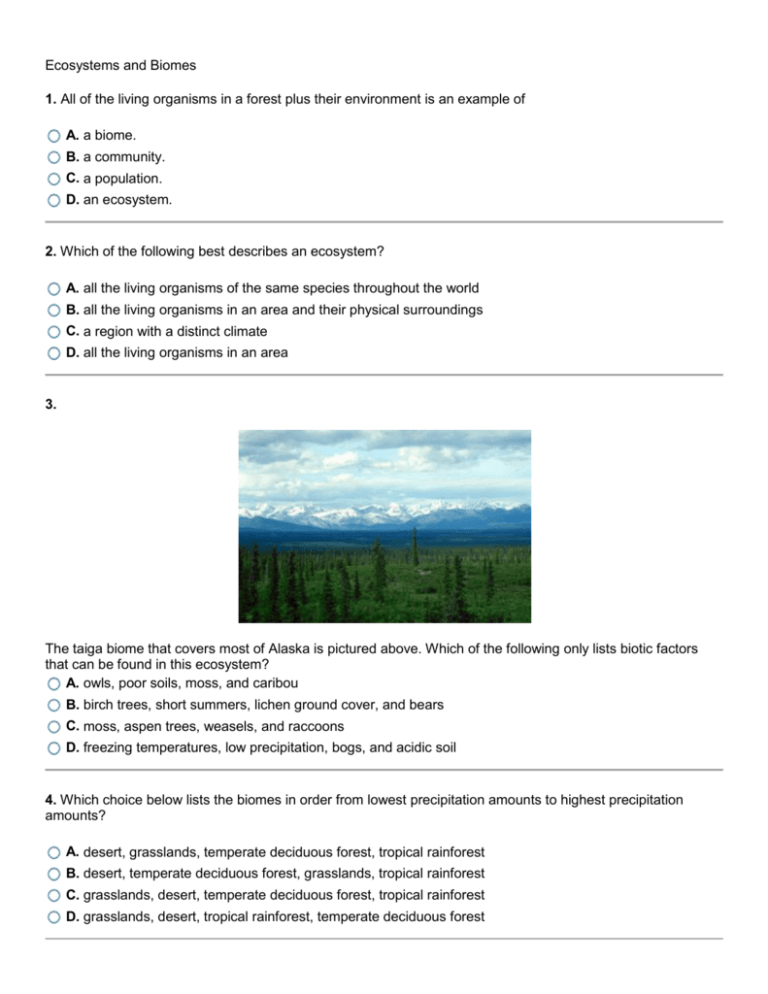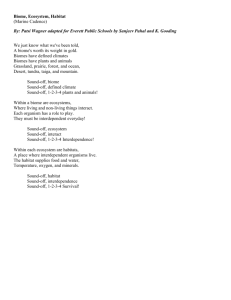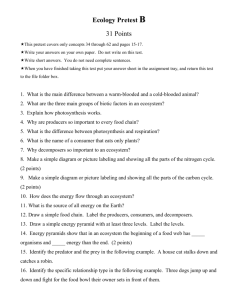Ecosystems and Biomes 1. All of the living organisms in a forest plus
advertisement

Ecosystems and Biomes 1. All of the living organisms in a forest plus their environment is an example of A. a biome. B. a community. C. a population. D. an ecosystem. 2. Which of the following best describes an ecosystem? A. all the living organisms of the same species throughout the world B. all the living organisms in an area and their physical surroundings C. a region with a distinct climate D. all the living organisms in an area 3. The taiga biome that covers most of Alaska is pictured above. Which of the following only lists biotic factors that can be found in this ecosystem? A. owls, poor soils, moss, and caribou B. birch trees, short summers, lichen ground cover, and bears C. moss, aspen trees, weasels, and raccoons D. freezing temperatures, low precipitation, bogs, and acidic soil 4. Which choice below lists the biomes in order from lowest precipitation amounts to highest precipitation amounts? A. desert, grasslands, temperate deciduous forest, tropical rainforest B. desert, temperate deciduous forest, grasslands, tropical rainforest C. grasslands, desert, temperate deciduous forest, tropical rainforest D. grasslands, desert, tropical rainforest, temperate deciduous forest 5. The large, grazing mammals typical of specific _______ biomes known as savannas include elephants, zebras, and giraffes. A. desert B. temperate forest C. grassland D. taiga 6. Grasslands are most likely to be described as having A. tall trees and thick vegetation. B. prairies and fertile soil. C. giraffes, gazelles, and rhinos. D. snow-capped mountains. 7. A desert with a hot, dry climate is an example of A. a biome. B. a population. C. an ecosystem. D. a community. 8. Technology Enhanced Questions are not available in Word format. 9. A desert biome is pictured above. Which is a biotic factor that can be found in this biome? A. a lizard B. a rock C. heat D. sand 10. Select the list below that would best exemplify a population. A. a school of sunfish B. bees and wasps around a group of purple cornflowers C. a warm, humid climate with plenty of rainfall D. a nest of mockingbirds, some bullfrogs, a pond, and a sandy shore 11. Which of the following is an example of a population? A. B. C. D. a hot, dry climate that receives very little rain the bank of a pond and the frogs and salamanders that live there a large clan of meerkats, including their offspring a pack of wolves chasing a family of deer through a grove of trees 12. Which choice below lists the biomes in order from lowest average temperatures to highest average temperatures? A. taiga, temperate deciduous forest, savanna B. tundra, savanna, temperate deciduous forest C. taiga, tropical rainforest, grasslands D. tundra, grasslands, taiga 13. A marine ecosystem is shown below. Which of the following lists includes only biotic factors that could be found in this ecosystem? A. fish, sea anemones, crustaceans B. fish, crustaceans, salt water C. rocks, sea anemones, sunlight D. crustaceans, rocks, sea anemones 14. What is the name for the nonliving parts of an ecosystem? A. abiotic factors B. biotic factors C. biome factors D. aerobic factors 15. A herd of cattle is an example of A. a community. B. an ecosystem. C. a population. D. a biome. 16. Which of the following shows the organizational level of a biome from the broadest category to the most specific category? A. biome → ecosystem → community → population → organism B. biome → population → community → ecosystem → organism C. biome → community → ecosystem → population → organism D. biome → ecosystem → population → community → organism 17. Succulent plants, such as cacti, are most often found in which terrestrial biome? A. desert B. rainforest C. grassland D. tundra 18. Select the list below that would best exemplify a community. A. a school of sunfish B. a nest of mockingbirds, some bullfrogs, a pond, and a sandy shore C. bees and wasps around a group of purple cornflowers D. a warm, humid climate with plenty of rainfall 19. A savanna ecosystem is shown below. _______ is an example of a(n) ________ factor of this ecosystem. A. Sunlight; abiotic B. Grass; abiotic C. Air; biotic D. Temperature range; biotic 20. Which of the following are abiotic factors that can be found in the ecosystem pictured? I. ocean currents II. fish III. plankton IV. sand A. II, III, and IV only B. I, II, and III only C. II and III only D. I and IV only 21. The biosphere can best be defined as A. all of the abiotic components of the Earth. B. any region on Earth where life can exist. C. a region with distinct climate characteristics. D. all of the plants on Earth. 22. A wetland ecosystem is shown below. Which of the following are abiotic factors of this ecosystem? I. temperature II. aquatic plants III. water IV. sunlight A. I and II only B. I, III, and IV only C. I, II, III, and IV D. II and III only 23. Savanna, tundra, grasslands, and temperate forest are examples of ______. A. biospheres B. communities C. biomes D. populations 24. Select the list below that would best exemplify an ecosystem. A. bees and wasps around a group of purple cornflowers B. a warm, humid climate with plenty of rainfall C. a nest of mockingbirds, some bullfrogs, a pond, and a sandy shore D. a school of sunfish 25. The animal species shown above would most likely be found wild in which of the following biomes? A. tropical rainforest B. grassland C. temperate forest D. arctic tundra 26. A pod of dolphins hunting and feeding on a school of fish is an example of A. a biome interaction. B. a population interaction. C. a community interaction. D. an ecosystem interaction. 27. A biome is a broad category of ecological organization that includes all of the biotic and abiotic components of an entire climate region, such as a desert or a rainforest. Which of the following categories of ecological organization is broader than a biome? A. a community B. a population C. the biosphere D. an ecosystem 28. Which biome is characterized by conifers, or trees whose seeds grow in cones? A. taiga B. tundra C. temperate deciduous forest D. tropical rainforest 29. A fight between a family of lions and family of hyenas over an animal carcass would be best described as competition between A. a community and an ecosystem. B. two different communities. C. two different populations. D. a population and a community. 30. The following table lists characteristics of rainforest biomes. Tropical Rainforest Characteristics Average annual rainfall 69 inches Average temperature Mild—around 64° F Representative plants Trees, vines, orchids, and bromeliads Representative animals Jaguars, kinkajous, and termites Abiotic factors found in rainforests include... A. rain, soil, and vines. B. kinkajous, termites, and rain. C. soil, rain, and mild temperatures. D. kinkajous, jaguars, and mild temperatures. Answers 1. D 2. B 3. C 4. A 5. C 6. B 7. A 8. -9. A 10. A 11. C 12. A 13. A 14. A 15. C 16. A 17. A 18. C 19. A 20. D 21. B 22. B 23. C 24. C 25. D 26. C 27. C 28. A 29. C 30. C Explanations 1. An ecosystem consists of all the living organisms in an area and their physical environment. All of the living organisms in a forest plus their physical environment is an example of an ecosystem. A population is a group of organisms from the same species in the same area. A herd of cattle is an example of a population. A community is made up of different populations that interact with each other. A pod of dolphins hunting and feeding on a school of fish is an example of a community interaction. A biome is a distinct climate zone. A desert with a hot, dry climate is an example of a biome. 2. An ecosystem includes all the living organisms in an area and their physical surroundings, or environment. 3. Biotic factors are the living components of an ecosystem. They include all types of plants and animals. Moss, aspen trees, weasels, and raccoons are all living, or biotic, factors common in the taiga biome. 4. Forests receive large amounts of precipitation needed to grow thick vegetation. As you might expect, rainforests receive more precipitation than any other biome. Grasslands do not receive enough precipitation for trees to grow, but receive more preciptation than deserts, which are the driest biome. 5. Large grazing mammals are plentiful in grassland ecosystems, such as the savanna. Elephants, giraffes, and zebra are commonly found in these large grassland biomes. Carnivorous mammals found here include lions, leopards, and hyenas. 6. Grasslands are known for their prairies and the most fertile soil of any biome. Grasslands do not receive enough rainfall to grow trees, but they are covered with short to tall grasses. Thanks to their fertile soil, many grasslands have been replaced with crops of corn and wheat. 7. A biome is a distinct climate zone. A desert with a hot, dry climate is an example of a biome. A population is a group of organisms from the same species in the same area. A herd of cattle is an example of a population. A community is made up of different populations that interact with each other. A pod of dolphins hunting and feeding on a school of fish is an example of a community interaction. An ecosystem consists of all the living organisms in an area and their physical environment. All of the living organisms in a forest plus their physical environment is an example of an ecosystem. 8. -9. Biotic factors are the living components of an ecosystem. They include all types of plants and animals. Lizards, insects, and cacti are all living, or biotic, factors common in the desert biome. Abiotic factors are nonliving components of an ecosystem. In a desert biome, sand, rocks, heat, and sunlight are abiotic factors. 10. A population is a group of organisms from the same species in the same area. A school of fish is an example of a population. A community is made up of different populations that interact with each other. Bees, wasps, and flowers together make up a community. An ecosystem consists of all the living organisms in an area, and their physical environment. A nest of mockingbirds, some bullfrogs, a pond, and a sandy shore together make up an ecosystem. A biome is a distinct climate zone. A tropical rainforest is an example of a biome. 11. A population is a group of interbreeding organisms from the same species that live in the same area at the same time and compete with each other for food, water, shelter, and mates. So, a clan of meerkats, including their offspring, is an example of a population. A community is made up of different populations that interact with each other. A pack of wolves chasing a group of deer is an example of a community interaction. An ecosystem consists of all the living organisms in an area and their physical environment. The bank of a pond and the frogs and salamanders that live there make up an ecosystem. A biome is a distinct climate zone. A hot, dry climate with very little rain, like a desert, is an example of a biome. 12. The tundra is the coldest biome, followed by the taiga. The tropical rainforest and savanna are the warmest biomes. Temperate deciduous forests and grasslands tend to have middle-range temperatures. These are the most common biomes of the United States. Deserts are in a unique category because they can have wide fluctuations in temperature, from extremely hot to extremely cold. 13. Biotic factors are the living components of an ecosystem. They include all types of plants and animals. Fish, sea anemones, and crustaceans are all living, or biotic, factors that can be found in marine ecosystems. Sunlight, salt water, and rocks are all abiotic, or nonliving, factors. 14. Biotic factors, such as trees, are the living parts of an ecosystem. Predators, food sources, and competitors are other examples of biotic factors. Abiotic factors are not, and have never been, alive. Air, temperature, moisture, salinity, and pH are all abiotic factors. All organisms within an ecosystem are influenced by the combination of the biotic and abiotic components in their environments. 15. A population is a group of organisms from the same species in the same area. A herd of cattle is an example of a population. A community is made up of different populations that interact with each other. A pod of dolphins hunting and feeding on a school of fish is an example of a community interaction. An ecosystem consists of all the living organisms in an area and their physical environment. All of the living organisms in a forest plus their physical environment is an example of an ecosystem. A biome is a distinct climate zone. A desert with a hot, dry climate is an example of a biome. 16. It is helpful for scientists to organize the biosphere into levels and categories. The organizational level of a biome from the broadest category to the most specific category is: biome → ecosystem → community → population → organism A biome is a region of distinct climate, such as a desert or rainforest. A biome is made up of separate (but similar) ecosystems. An ecosystem includes all the living organisms in an area and their physical environment. An ecosystem is made up of communities. A community is made up of different, interacting populations. A population is a group of organisms of the same species living in a particular place. 17. Succulent plants, such as cacti, are adapted to be able to withstand very dry conditions. Therefore, they are most often found in desert biomes, which are very hot and dry. 18. A community is made up of different populations that interact with each other. Bees, wasps, and flowers together make up a community. A population is a group of organisms from the same species in the same area. A school of fish is an example of a population. An ecosystem consists of all the living organisms in an area, and their physical environment. A nest of mockingbirds, some bullfrogs, a pond, and a sandy shore together make up an ecosystem. A biome is a distinct climate zone. A tropical rainforest is an example of a biome. 19. Abiotic factors make up the nonliving portion of an ecosystem. Sunlight, average temperature range, and air are examples of abiotic factors of an ecosystem. Grass is a biotic, or living, component of a savanna ecosystem. 20. Abiotic factors make up the nonliving portion of an ecosystem. In an ocean ecosystem, such as the one pictured, ocean currents and sand are abiotic factors. Plankton and fish are living and are therefore biotic. 21. The biosphere is any region on Earth where life can exist, including water, land, and air. It is the broadest category of ecological organization. Every ecosystem in every biome on Earth is part of the biosphere. 22. Abiotic factors make up the nonliving portion of an ecosystem. Temperature, sunlight, and water are examples of abiotic factors of an ecosystem. Aquatic plants are biotic, or living, components of a wetland ecosystem. 23. Savannah, tundra, grasslands, and temperate forest are examples of biomes. Biomes are regions that have a distinct climate. 24. A population is a group of organisms from the same species in the same area. A school of fish is an example of a population. A community is made up of different populations that interact with each other. Bees, wasps, and flowers together make up a community. An ecosystem consists of all the living organisms in an area, and their physical environment. A nest of mockingbirds, some bullfrogs, a pond, and a sandy shore together make up an ecosystem. A biome is a distinct climate zone. A tropical rainforest is an example of a biome. 25. Arctic foxes, polar bears, and caribou are common animal species found in the arctic tundra biome. The arctic tundra is very cold with little precipitation and a lack of nutrients. Therefore, the plants and animals that live there must be highly adapted to survive in these unique conditions. 26. A community is made up of different populations that interact with each other. A pod of dolphins hunting and feeding on a school of fish is an example of a community interaction. A population is a group of organisms from the same species in the same area. A herd of cattle is an example of a population. An ecosystem consists of all the living organisms in an area and their physical environment. All of the living organisms in a forest plus their physical environment is an example of an ecosystem. A biome is a distinct climate zone. A desert with a hot, dry climate is an example of a biome. 27. The biosphere is any region on Earth where life can exist, including water, land, and air. It is the broadest category of ecological organization. Every ecosystem in every biome on Earth is part of the biosphere. 28. The characteristic plant of the taiga is the conifer. The waxy, needle-shaped leaves of conifers help them retain water when water in the ground is frozen, and do not fall off during winter. This helps conifers survive the harsh, cold temperatures. 29. A population is a group of organisms of the same species living in a particular place. A family of lions and a family of hyenas are two distinct populations. Together, the populations of the hyenas and the lions make up a community. 30. Biotic factors are the living components of an ecosystem. They include all types of plants and animals. Jaguars, kinkajous, termites, trees, vines, orchids, and bromeliads are all biotic factors in the rainforest biome. Abiotic factors are nonliving components of an ecosystem. Abiotic factors of a rainforest biome include soil, rain, and mild temperatures.







